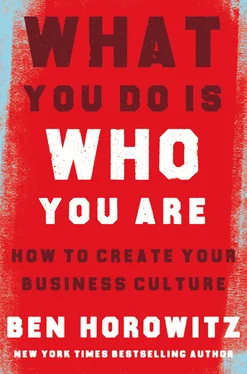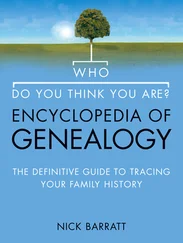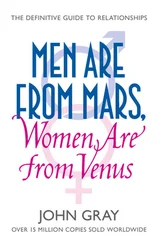Imagine a culture of strict accountability that punishes failure—a very common culture back east, where executives strove to maintain their status, and failure was to be avoided at all costs. Now consider an idea that has a 90 percent chance of failing, but that would pay off at 1,000 to 1. Despite it being an extraordinarily good bet, the company that punishes failure will never fund it.
Hierarchies are good at weeding out obviously bad ideas. By the time an idea makes it all the way up the chain, it will have been compared to all the other ideas in the system, with the obviously good ideas ranked at the top. This seems like common sense. The problem is that obviously good ideas are not truly innovative, and truly innovative ideas often look like very bad ideas when they’re introduced. Western Union famously passed on the opportunity to buy Alexander Graham Bell’s patents and technology for the telephone. At the time, phone calls were extremely noisy and easy to misinterpret, and they couldn’t span long distances, and Western Union knew from its telegram business that profitable communication depended on accuracy and widespread reach. And Wikipedia was considered a joke when it started. How could something written by a crowd replace the work of the world’s top scholars? Today it is so much more comprehensive than anything that came before it that it’s widely considered the only encyclopedia.
The Intel culture, by elevating the individual and giving breakthrough ideas a chance, inaugurated a better way to do business. My business partner Marc Andreessen wrote an essay a few years ago called “Software Is Eating the World.” He described how technology has spread beyond the technology industry to take over every traditional business, from bookstores to taxi fleets to hotels. Existing companies have been forced to adopt aspects of Noyce’s culture or else expose themselves to an onslaught of existential threats. We’ve seen General Motors adopt stock options as it moved into autonomous vehicles by buying Cruise Automation, and Walmart employ a similar approach with its purchase of Jet.com.
Since tech became a consumer phenomenon, thousands of nontech people have come up with great ideas that use technology. But if their startups outsource their engineering, they almost always fail. Why? It turns out that it’s easy to build an app or a website that meets the specification of some initial idea, but far more difficult to build something that will scale, evolve, handle edge cases gracefully, etc. A great engineer will only invest the time and effort to do all those things, to build a product that will grow with the company, if she has ownership in the company—literally as well as figuratively. Bob Noyce understood that, created the culture to support it, and changed the world.
WHAT MAKES A CULTURE WORK?
Culture clearly has a powerful effect. So how do you shape it, how do you set it deep in people’s minds, and how do you fix it when it goes wrong?
These questions led me to larger questions and a wider frame of reference. How does culture work in a variety of different contexts? What makes it last for more than a few years?
I have long been interested in history, and particularly in how people behaved differently from what I would have expected, given the circumstances they were born into. For instance, I would never have expected that a man who was born into slavery and who would one day free the slaves of Haiti would own slaves himself along the way—but he did. Understanding how historical cultures shaped people’s views led me to begin considering what they had to do to change themselves and their culture. Grasping that seemed to be the key to creating the kind of culture that I wanted.
I selected four models in particular, one of whom is still very much alive. I wasn’t looking for ideal cultural end states—some of the models produced extremely violent or otherwise problematic cultures—but for people who were outstandingly effective in getting the cultures they wanted. Each of these models made me ask giant questions:
Why has there been only one successful slave revolt in human history? And how did Haiti’s Toussaint Louverture reprogram slave culture to orchestrate it?
How did bushido, the code of the samurai, enable the warrior class to rule Japan for seven hundred years and shape modern Japanese culture? What set of cultural virtues empowered them? The samurai called their principles “virtues” rather than “values”; virtues are what you do , while values are merely what you believe. As we’ll see, doing is what matters. (In what follows I will use “virtues” to refer to the ideal, and “values” to refer to what most companies now espouse.) How exactly did the samurai focus their culture on actions?
How did Genghis Khan build the world’s largest empire? He was a total outsider, imprisoned as a youngster by his own tiny nomadic tribe. It’s easy to see how that made him want to smash existing hierarchies. But how, exactly, was he able to create an innovative and inclusive meritocracy? One that enabled him to constantly grow and improve while his foes were standing still?
How did Shaka Senghor, sentenced to nineteen years in a Michigan prison for murder, make his prison gang the tightest, most ferocious group in the yard—and then transform it into something else entirely? How did culture turn him into a killer? How did he rise to dominate that culture? How did he take a group of outcasts and turn them into a cohesive team? Finally, how did he recognize what he disliked about his regime, and, by changing himself, change the entire prison culture?
Companies—just like gangs, armies, and nations—are large organizations that rise or fall because of the daily microbehaviors of the human beings that compose them. But figuring out whether the root cause of a company’s success is its culture or some other factor isn’t easy. Most business books don’t look at culture from a wider, more sociological perspective. And most attempt to dissect successful companies’ cultures after the companies have succeeded. This approach confuses cause and effect. There are plenty of massively successful companies with weak, inconsistent, or even toxic cultures; a desirable product can overcome a miserable environment, at least for a while. If you don’t believe me, read up on Enron.
To avoid survivorship bias—the logical error of concentrating on companies that succeeded and falsely concluding that it was their culture that made them great—I try not to reverse engineer. Instead I look at the cultural techniques that leaders used as they tried to strengthen their culture in specific ways, and show how those efforts played out. So you won’t find any absolute “best cultures” in this book, just techniques to make your own culture do what you want it to.
I start by examining the four historical models described earlier, and then break out modern-day examples of those same cultural techniques. As you read these first seven chapters, think about how leaders like Toussaint Louverture and Genghis Khan saw culture, and the tools they devised to shift it even under extremely difficult circumstances, when everything seemed to be conspiring against them. Take note of practices you might want to emulate, and how perspectives well outside your own might be surprisingly pertinent. How did the samurai design a culture whose elements all fit neatly together? How is Shaka Senghor’s experience, coming into prison as a young man and having to figure out how it worked, relevant to new employees at your company?
Creating a culture is more complex than just trying to get your people to behave the way you want them to when no one is looking. Remember that your employees are far from uniform. They come from different countries, races, genders, backgrounds, even eras. Each one brings to your organization a different cultural point of departure. To get all of them to conform to and be reasonably happy with a common set of norms is a challenging puzzle.
Читать дальше












